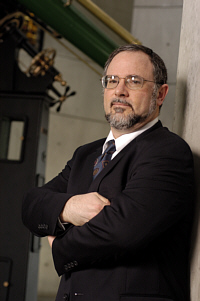
News Release
|
Office of News and Information Johns Hopkins University 901 South Bond Street, Suite 540 Baltimore, Maryland 21231 Phone: 443-287-9960 | Fax: 443-287-9920 |
January 27, 2005 FOR IMMEDIATE RELEASE CONTACT: Lisa De Nike (443) 287-9906 lde@jhu.edu |
Quadrennial Draper Medal
NAS recognizes Bennett's work analyzing age,
composition and curvature of universe
Charles L. Bennett, a professor in the Henry A. Rowland Department of Physics and Astronomy at The Johns Hopkins University, will be awarded the prestigious Henry Draper Medal on May 2 at the National Academy of Science's 142nd annual meeting.
The academy awards the Draper Medal every four years to scientists and individuals who have made significant contributions to astronomical physics. The prize was established in 1886 by the wife of Henry Draper, a prominent amateur scientist and early pioneer of astronomical photography.
 |
| Charles L. Bennett |
The NAS cited Bennett for his work with the Wilkinson Microwave Anisotropy Probe (WMAP), a NASA Explorer mission that is working to precisely determine the age, composition and curvature of the universe.
WMAP measures the temperature of cosmic background radiation, the oldest light in the universe and a remnant of the Big Bang. Using the WMAP satellite, Bennett's team has taken the universe's first-ever, detailed, full-sky "baby picture" in microwave light from 379,000 years after the Big Bang. The microwave light mapped by WMAP has traveled across the universe for more than 13 billion years and now provides us with a direct picture of what the universe was like then.
"It's as if a photo of a 13-month old baby was mailed to a relative and got delayed in delivery. Decades later, the relative receives the picture of the now-80-year-old relation!" Bennett explains. "Using WMAP, we see what our universe looked like in its infancy, and using instruments such as the Sloan Digital Sky Survey and the Hubble Space Telescope, we see how our universe evolved more recently. Combining all that information has revealed the 13.7 billion year age of the universe, and has clearly established that the universe is dominated by a mysterious dark matter and an even more mysterious dark energy. That dark energy is causing the universe to stretch at ever- increasing rates. Determining the nature of that energy is the pre-eminent problem in physics."
Bennett came to Johns Hopkins on January 1, 2005, from his position as a senior scientist for experimental cosmology at NASA's Goddard Space Flight Center, where the WMAP was built in partnership with Princeton University. He is the third Johns Hopkins scientist to win the Draper Medal. Henry A. Rowland, Johns Hopkins' first physics professor, received the award in 1890 and Robert W. Wood, who was professor of experimental physics at Johns Hopkins, won in 1940.
"It's a great honor to receive the Henry Draper Medal from the National Academy of Sciences. I take it as recognition of my teachers and mentors, my wonderful scientific colleagues, and the loving support of my family," Bennett said.
Bennett's research has been funded by NASA.
Color photos of Bennett are available upon request. Contact Lisa De Nike.
|
Johns Hopkins University news releases can be found on the
World Wide Web at
http://www.jhu.edu/news_info/news/ Information on automatic e-mail delivery of science and medical news releases is available at the same address.
|
 Go to
Headlines@HopkinsHome Page
Go to
Headlines@HopkinsHome Page